Months of Meryl: A Cry in the Dark (1988)
 Thursday, April 12, 2018 at 3:00PM
Thursday, April 12, 2018 at 3:00PM John and Matthew are watching every single live-action film starring Meryl Streep.
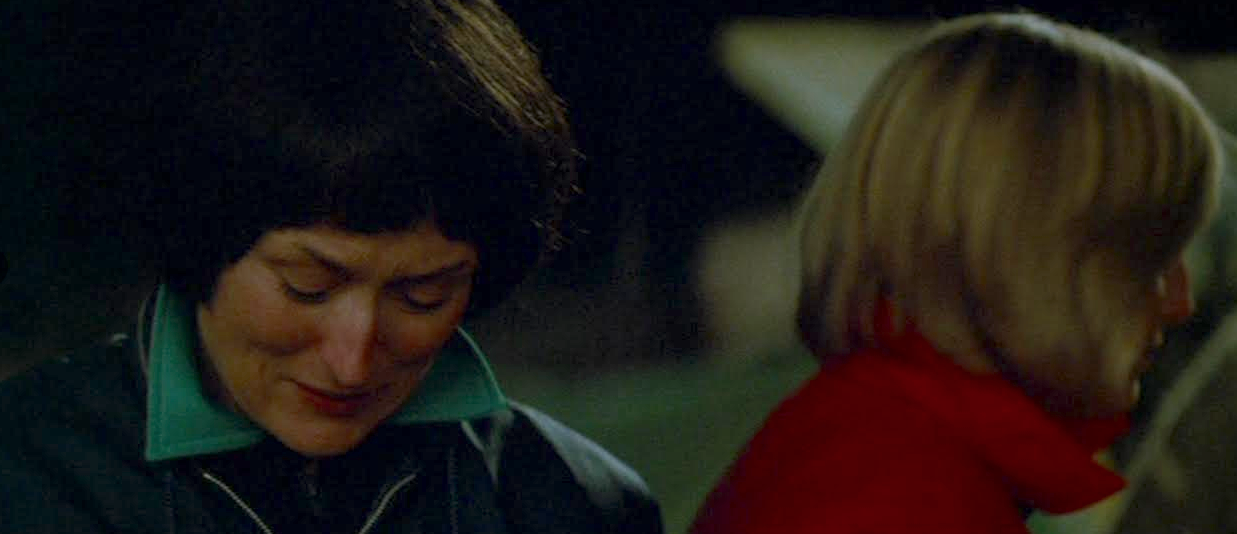
#15 — Lindy Chamberlain, a New Zealand matriarch wrongfully convicted of her child’s murder.
MATTHEW: One evening in August 1980, Azaria Chamberlain, the two month-old daughter of New Zealander couple Michael and Lindy Chamberlain, was taken while the family was camping near Ayers Rock. She was never found again. Seconds before Azaria disappeared, Lindy claimed to have seen a dingo rummaging through the tent where her daughter lay sleeping, putting forth the soon-to-be-infamous story that a dingo had taken and perhaps eaten her baby. A seedy, sensationalist media frenzy ensued, with the Chamberlains’ faces splashed across the covers of obsessive tabloids and speculative segments of nightly news programs as many, including the Australian high court, viciously questioned the veracity of the family’s explanation.
None of Meryl Streep’s vehicles have entered the cultural lexicon with quite the same measure of gleefully ubiquitous parody that has surrounded and even overshadowed Fred Schepisi’s 1988 docudrama A Cry in the Dark, also titled — and released in Australia and New Zealand as — Evil Angels after the John Bryson true-crime bestseller that first chronicled the Chamberlain family’s legal ordeal. A Cry in the Dark’s devolution into little more than a widely-known (though often misquoted) punchline has proven to be both admittedly hilarious but also fairly odd, especially considering the gruesome events from which this gag originates...
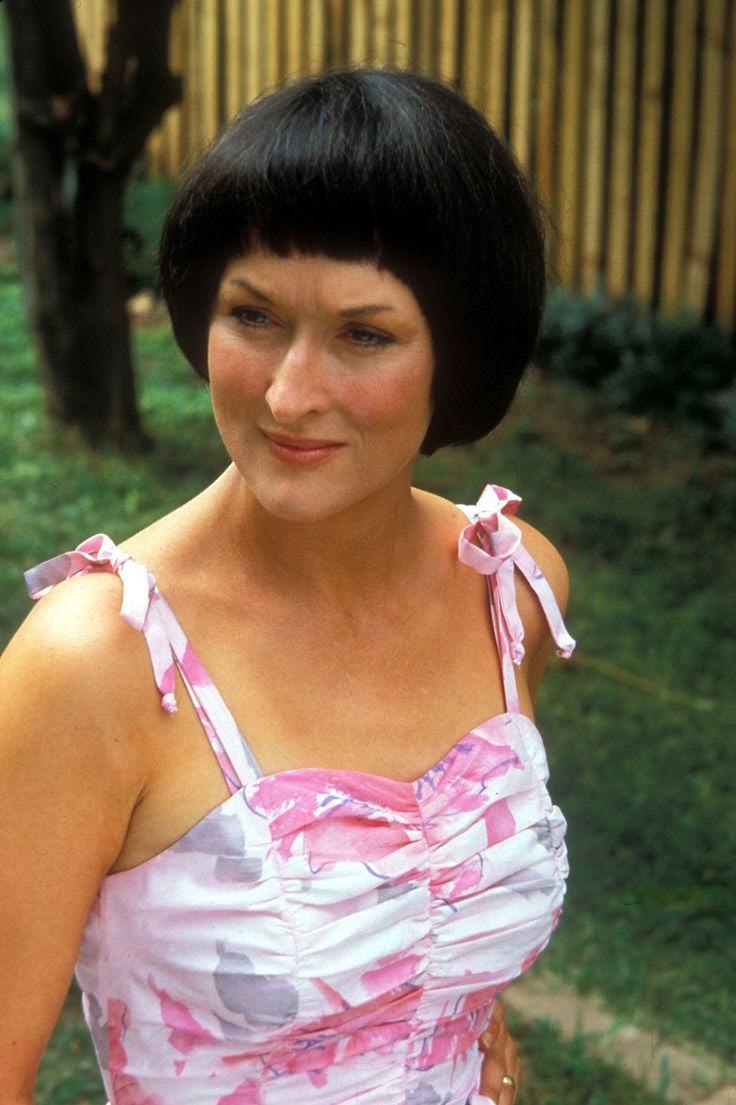 But Streep’s performance as the embattled and eventually imprisoned Lindy has survived her film’s farcical reputation (and her own helmet-hair bowl cut) largely unscathed. It was warmly received upon its debut, earning an Oscar nomination and a Best Actress prize at the 1989 Cannes Film Festival from Wim Wenders’ jury, and it’s easy to understand why. In the earliest, pre-tragedy passages of A Cry in the Dark, Streep simply decides, rather ingeniously, to play a normal family woman and thus eschews any one dominant characteristic. She’s a Seventh-day Adventist pastor’s wife who is neither a zealot nor a stick in the mud, a mother of three who is traditional and practical enough to make her children’s clothing but particular enough to dress her newborn daughter in off-putting gothic black because, as she sweetly puts it, she just likes the color. When the film soon arrives at Azaria’s demise, Streep wipes away any instinct one might have to snigger at all the extensive dingo-mentioning by diligently and distressingly playing this sequence — and its grief-stricken aftermath — as the traumatic horror show it is.
But Streep’s performance as the embattled and eventually imprisoned Lindy has survived her film’s farcical reputation (and her own helmet-hair bowl cut) largely unscathed. It was warmly received upon its debut, earning an Oscar nomination and a Best Actress prize at the 1989 Cannes Film Festival from Wim Wenders’ jury, and it’s easy to understand why. In the earliest, pre-tragedy passages of A Cry in the Dark, Streep simply decides, rather ingeniously, to play a normal family woman and thus eschews any one dominant characteristic. She’s a Seventh-day Adventist pastor’s wife who is neither a zealot nor a stick in the mud, a mother of three who is traditional and practical enough to make her children’s clothing but particular enough to dress her newborn daughter in off-putting gothic black because, as she sweetly puts it, she just likes the color. When the film soon arrives at Azaria’s demise, Streep wipes away any instinct one might have to snigger at all the extensive dingo-mentioning by diligently and distressingly playing this sequence — and its grief-stricken aftermath — as the traumatic horror show it is.
As A Cry in the Dark progresses, Schepisi and co-writer Robert Caswell widen the story’s scope to encompass the reporters, prosecutors, and everyday Australians who exist outside the Chamberlains’ inner circle, taking up a frenetic, panoramic approach that provides vivid flashes of character rather than sustained immersion. Streep has always excelled more in the latter mode, but she uses her screen time ideally, refusing to make Lindy easy to warm to, either for us or for those around her, including the ones who hold her nearest and dearest. Even in the wake of loss, she still positions Lindy as an ever-pragmatic matriarch, whether she’s weighing the implications (or maybe just the personal toll) of allowing a Woman’s Day reporter into her home or expressing muted gratitude that her son’s bloody jacket won’t need to be taken in as evidence because it’s the only one he owns. Streep can plainly communicate Lindy’s ambivalence around that cunning tabloid hound (coolly played by Deborra Lee-Furness, aka Mrs. Hugh Jackman) with just a few well-placed shifts in her gaze, and the economy of her playing ultimately comes to match the overall concision of the film’s structure. So there’s definitely much to admire in Streep’s performance, although I must admit that it’s not one I find myself often returning to. Maybe it’s the erratic, amped-up nature of Schepisi’s filmmaking, but I can never recall A Cry in the Dark, or Streep’s work therein, with the same crystal-clear clarity with which I immediately remember Sophie’s Choice or Silkwood. But what’s your stance on the notorious Lindy Chamberlain?
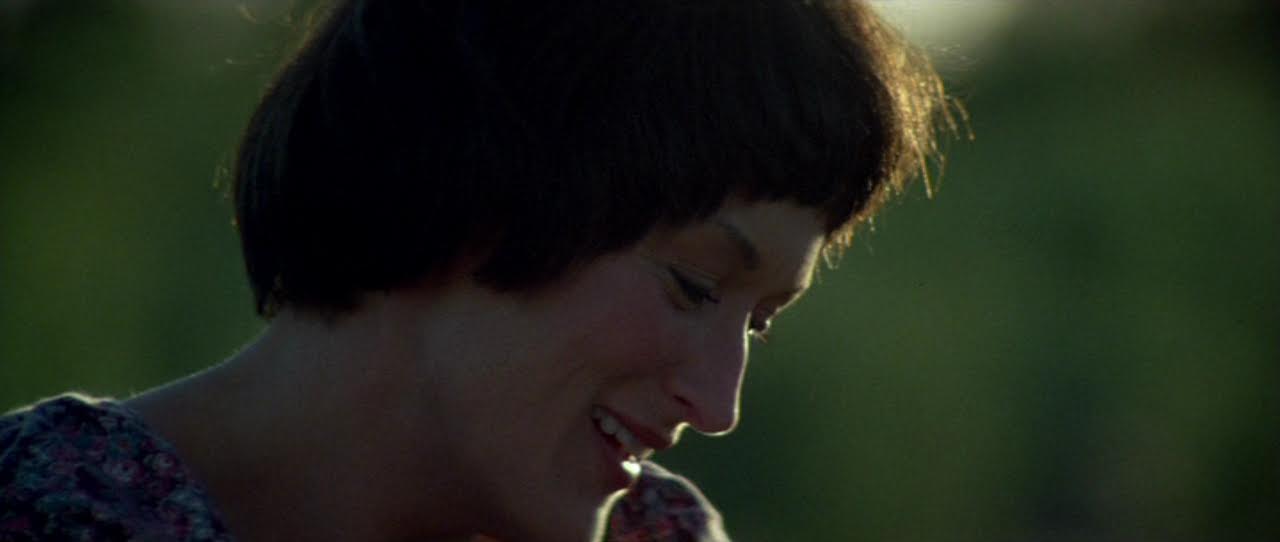
JOHN: A Cry in the Dark strikes me as Exhibit A for (misguided) critics who accuse Streep of being technically perfect but emotionally bankrupt. A lazy and frankly misogynist critique, “emotional distance” or internalized expression or any sort of actorly withholding is a strategic and deliberate choice here, and in other Streep performances, that asks the viewer to lean into and study the character rather than be spoon-fed some easy idea about this woman. Screen acting is never mere representation, and actressing especially often operates from a place of both representation and interrogation. If you’ll allow me to go out on a meta limb here, Lindy Chamberlain is a performance by an actress both inhabiting the role while also responding to the media image of Lindy Chamberlain that had already been created and which ultimately led to her imprisonment. Streep spins many plates in A Cry in the Dark, but perhaps her most impressive feat is her absolute refusal to soften Lindy into a saccharine symbol, choosing instead to double down on yet another difficult woman in her intrepid repertoire. In so doing, Streep recuperates Lindy from tabloid fodder while testing the viewer’s empathic capabilities.
After making remoteness utterly devastating in Ironweed, here Streep makes remoteness downright terrifying, once again executing a total physical (and vocal) transformation entirely in service to her character. I’m of the mind that a viewer never forgets the actor they’re watching onscreen, and that’s perfectly fine. When actors transform, they inevitably bring themselves to the character. Chameleonic Meryl occasionally has traces of Real-Gal Meryl or Whip-Smart Meryl or just plain Meryl-Meryl, but Lindy Chamberlain’s disquieting calm and eerie remove is perhaps the closest I’ve come to ever “forgetting” the actress underneath. Rather than work to fill in the blanks of an underwritten part or breathe life into an abstraction, Streep must simultaneously alienate and compel the viewer by playing all the abrasive and iron-willed reserve that indicted Lindy while inviting sympathy with such a headstrong strange woman. This extremely challenging task is, of course, matched by Streep’s staggering talent, put to use here like an athlete playing a charity game. In this joyless and often taxing film, there is immense pleasure in simply witnessing Streep pull off this first-rate performance.
Lindy Chamberlain is clearly a fierce queen and goth hero, something about her work here doesn’t ignite the same passion I maintain for other early peaks — and I get that this may be entirely purposeful. An unusual performance in many respects, I’m pressed to recall a scene or moment that captures the essence of Streep’s Lindy. What’s her “Oscar clip”? The obvious answer is her testimony, where she conveys the gruesome details of the incident with utmost clarity and discomfort. “We’re talking about my baby daughter,” she says, voice cracking and eyes tearing, before steeling herself to declare, “not some object,” allowing herself just a few syllables of indignation. In lieu of a clip, I’d rather put together a montage of Lindy hiding from the press, undisguised in bulky black sunglasses and ducking from cameramen like a true-blue celebrity. What other scenes stand out for you in Streep’s performance?
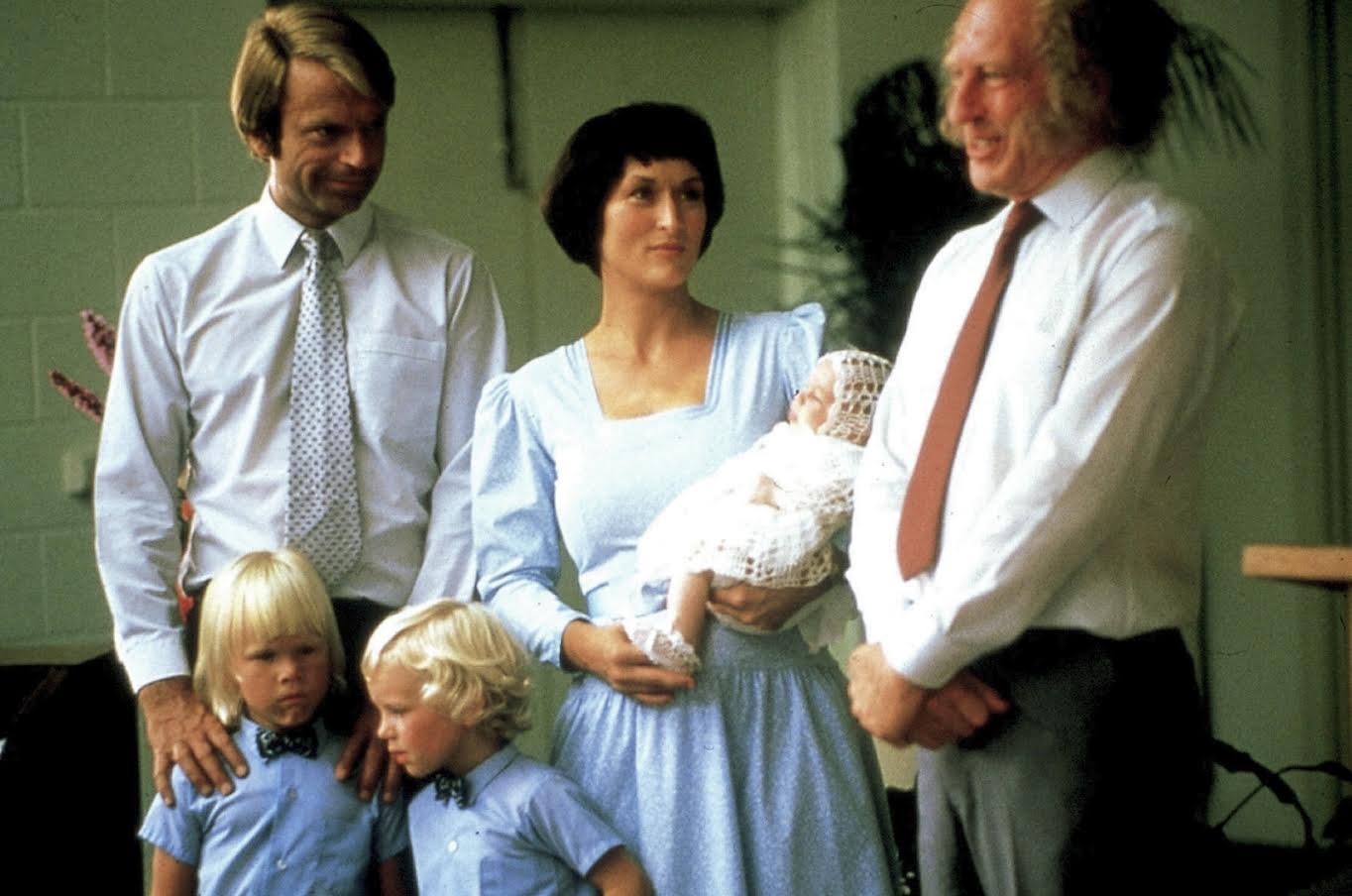
MATTHEW: “You can crack walnuts on her face,” a fleeting, at-home commentator remarks about Lindy midway through the movie. Have Streep’s features ever been morphed so severely? That pinched face with its pointy nose and thin, perpetually-arched brows would seem to prohibit any and all signs of levity, which is why it’s invariably surprising, upon each rewatch of A Cry in the Dark, just how much gaiety Streep manages to sneak into the performance. I relish Lindy’s airier moments of giggling, goosey abandon that reveal a healthy and often self-deprecating sense of humor that can evidently not be contained: burying her chuckles at a bumbling reporter who topples backward during a visit to the campsite where Azaria disappeared; making light of a bomb threat that she inadvertently predicted at the hotel she and her husband Michael (Sam Neill) are stuck in; or howling with incredulous laughter at a woman who hurls a loogie into the telephone booth in which she’s making a call.
Streep also gains a most worthy acting counterpart in Neill, a robust and underrated actor who has always been willing to play second and even third banana in stories that are fundamentally female-focused, from My Brilliant Career to A Cry in the Dark to The Piano. Neill casually sells Michael’s religious conviction early on, but it’s his spiking exasperation with his faith, his wife, and his country’s judicial system that makes for some of the film’s more forceful scenes. Michael’s explosive outbursts and muddled breakdowns position Streep as a witness and allow her to turn the quieter modes of watching and listening into active and compulsively watchable behavioral choices. This isn’t to say that Streep doesn’t ever resort to histrionics: she goes big and weepy during a lacerating argument with Michael that transpires halfway through the trial in their dingy, temporary living quarters, exposing the discomfiting fissures of this seemingly solid union. (In reality, the Chamberlains split up in 1991, five years after Lindy was released from prison.) But the occasional histrionic is far more preferable than dewy sentimentality, which, I agree, Streep steers clear of altogether. She manages to maintain Lindy’s steeliness but shuns garish caricature, even in the dramatic incidents that appear to beg for some imperious Dragon Queen flourishes. But Streep, by and large, refrains from such overemphasis. She can scoff, stare daggers, and roll her eyes at the prosecution’s admittedly insufferable forensics expert, who has also stolen Lindy’s haircut, and still sell these actions as those of a credible but infuriated human being, as opposed to the vindictive virago that the mainstream press would like her to embody.
Streep and her fellow filmmakers stand in firm opposition to the ingrained misogyny that quickly came to define the media circus that encircled the Chamberlains both during the hearings and in their ongoing aftermath. (The case has been reopened as recently as 2011.) Although its sum total is far less galvanizing, A Cry in the Dark’s thematic interests are not too distant from those of American Crime Story: The People v. O.J. Simpson, another compassionate retrieval of a reluctant female media fixture’s maligned legacy. Streep’s measured, many-sided characterization refuses to let Lindy be defined by her grief, but it also avoids heroizing her hardships as a more self-aggrandizing performance might have been inclined to do. Besides, Streep carefully demonstrates Lindy’s virtues at her own pace. By the time Lindy is being hauled off to prison (a ruling that emotionally undoes Michael more than anyone), Streep has steadily established her as the sturdy backbone of this familial unit, not through any explicit proclamations but through the tacit vigilance with which Lindy safeguards her brood. Such modest playing is far more authentic than the emotional bold strokes that are the dubious hallmarks of these ripped-from-the-headlines bio-dramas. Consider Lindy’s reunion with her family, including the daughter she gave birth to while incarcerated, an exchange that one envisions being written with the warm, salty tears of audiences. Streep doesn’t indulge this already soft-hearted set-up, opting instead to wisely assure her daughter, who shrinks away from the mother who is all but a stranger to her, that they will have plenty of time to bridge the divide that her conviction has forced. By privileging tough-minded truth over ephemeral schmaltz, Streep humblingly imparts that the lives the Chamberlains lived before can never be returned to, but that healing is possible, if not easy.
JOHN: “I'm told, ‘Don't talk like you normally talk. Watch how you hold your mouth. You look too sour and crabby. Don't get angry. Don't ask too many questions, or they think you're trying to be smart. And never, never, never laugh or you're an uncaring bitch.’ Well, I can't cry to order, and I won't be squashed into some dumb act for the public ... or for you,” Lindy declares on the stand. It’s not hard to read Lindy’s refusal to perform some 'dumb act for the public' as closely related to Streep’s own determination to discover all the rough edges and unpalatable qualities of difficult characters. These courtroom scenes, though Lindy’s most public moments, stand out as the most concentrated and intimate time we spend with Lindy and her private thoughts. Additionally, we are granted a rare, sustained close-up of Lindy as she defends herself, which contrasts with how Lindy is usually framed as just one of many, the camera carefully keeping its distance whether in a motel or in her home, sharing affection with her husband.
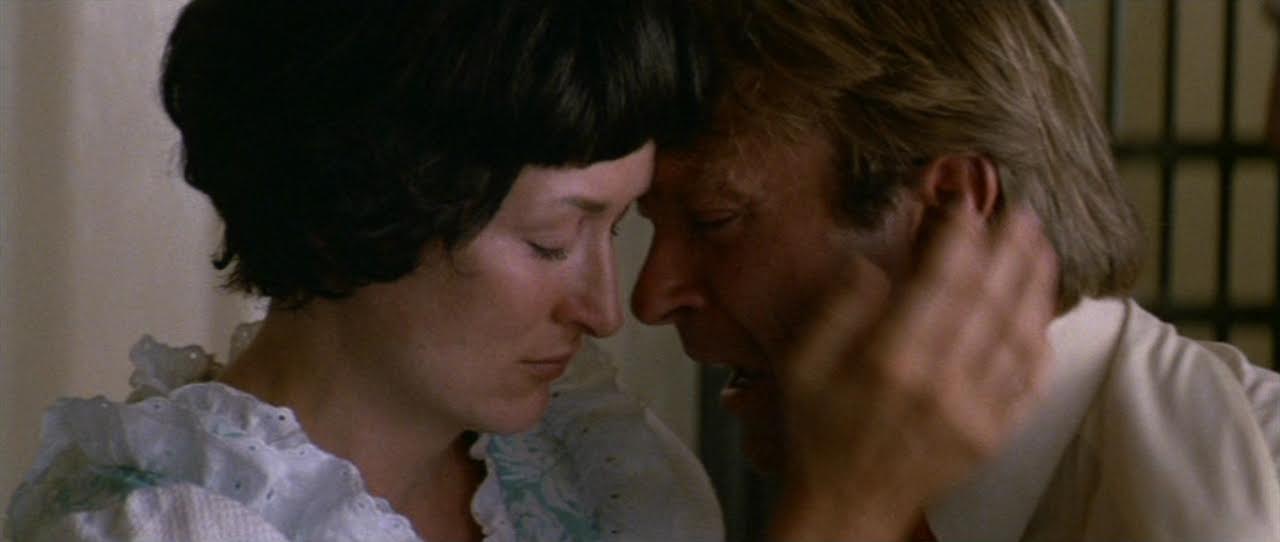
Such tactical moves underscore Schepisi’s decision to scale back and unsettle an audience’s expectation of “getting to know” the characters we see on screen. In this respect, both Schepisi and Streep work hard to keep Lindy at an immense remove from our scrutiny, rebuffing the insatiable hunger for fallacious gossip and invasive copy that led to her sentence. By the end of A Cry in the Dark, Lindy Chamberlain remains an aloof figure. My gut reaction is to criticize films that fall short of painting a full picture of the characters they spend hours observing, but A Cry in the Dark, and its centerpiece performance, make such detachment puzzling and purposeful.




Reader Comments (47)
I think she's astounding in this. Top 5 Meryl, for me.
I always thought this was one of Streep's finest performances.
Streep is superb but good heavens is the film dreary.
Agreed superb the testimony scenes are her clips as you stated but she is great it the total exasperation of the press,eye rolling,smirking,avy hands.but Close wins 88
A good right up guys.
My second favourite Meryl performance after Julie and Julia.
CORRECTION Though - The film is set in Australia, not New Zealand.
Meryl's superb, but my favorite female performance of 1988 is funnily enough, a genuine Australian - Judy Davis in High Tide. She won the National Society of Film Critics Award that year, but the film seems to have disappeared without a trace. An undeserved fate.
Has always been, and will probably always stand to be, Meryl's greatest performance in my opinion.
PS ken s., if you're anywhere near Canberra this weekend, come to a film society screening of HIGH TIDE that I will be introducing! (Sorry, couldn't help but take advantage of the coincidence.). Link:
http://reelmccoy.org.au/
Travis C. Thanks for the invite, but unless you're talking about Canberra Ohio (or somewhere in the Midwest USA) I'm not in the neighborhood. But I am very glad to hear that the film is still circulating around. The film itself is wonderful and Judy Davis is magnificent. Cheers!
I agree with John, this is the performance I think where Meryl most 'disappears'.
And agree with Adam Lewis, it's my favourite Meryl performance alongside Julie & Julia
I prefer any scene of Carmen Maura in Mujeres... ten thousand times more.
We really need a 1988 smackdown
Haha, no, ken s, I'm afraid the capital of Australia could be maybe one of the furthest spots on Earth from your residence. (But interesting to know about the existence of the Canberra Corporation in Ohio.......)
Maura is amazing, Sarandon is amazing, Melanie is great considering she's Melanie, but they're all in comedies! You all say you love comedies but never vote for them and then Meryl comes around with a horrendous wig and an accent and you all go berserk.
Susan Sarandon's at her sexy best in 88,shame Griffith took up her spot,I am only assuming she landed 6th.
@Pepa Pepa What has a Mexican movie have to do with this movie???? Stupid comment.
This is my favorite Streep performance.
Don't forget Christine Lahti in Running on Empty. She shoulda been nommed.
@brookeboy totally agree with you.
She's mischievously calculating here, and with good measure. It's a perfectly modulated performance, immensely tricky to pull off but she does it so so sooo well. I always think of this performance when people accuse Streep of gimmicky (which sure she can be) because it's a total transformation and it never feels like an act. Which plays really well into what the movie is doing.
Meh movie, but loooooove Streep in it.
Possibly top 5 Streep performance. Brilliant character work and accent. Back to back with IRONWEED I think soured some people towards seeing performances of her “difficult” women leading to a couple years of comedy.
I love Streep in this but not sure if I would have nominated here -- not because she wasn't deserving, SURE WAS! but because it was such an amazing year for leading ladies. 1988 was heaven with Actressing.
grrr -- Guess you never took geography.
This movie is Australian, just btw. Not set in New Zealand (although Chamberlain was, I believe of both Australian and New Zealand heritage)
It's an important distinction because what makes the film work - even more so than Streep; although it's worth adding that a lot of Australians HATE this performance because of her accent work - is the way Schepisi focuses on the ferocious attitudes towards Lindy from the Australian public and the press.
Nathaniel, preach. Such a year. Barbara Hershey in A World Apart and Diane Keaton in The Good Mother.
Gena Rowlands (Another Woman)
Sandy Dennis (Another Woman)
Barbara Hershey (The Last Temptation of Christ)
Genevieve Bujold (Dead Ringers)
Catherine O'Hara (Beetlejuice)
There's no denying that '88 was a harvest romp for actresses but I would still nominate her for BA for her searing performance in this movie. One of her best!
3rtful aren't the ones you listed supporting bar Gena.
it is impossible to overstate how HUGE the azaria chamberlain story was down here [in australia]; it spanned nearly the entire decade of the 1980s and was never far from the daily headlines. the twists and turns and reversals of fortune were astounding. there's a snippet of a scene in the film that sums up the national hysteria: a woman declares to her gossiping guests "i am not having another dinner party ruined by those dreadful people". EVERYBODY had an opinion and a theory.
i can only admire meryl's take on the role - to us she was playing a person we all "knew" and i think she pretty much nailed it. it is my favourite performance of hers [give or take the first five minutes of death becomes her]. sam neill is sensational as well
'evil angels' is such a great title. 'a cry in the dark' sounds like the title of a film someone was nominated for in a movie that features a fake oscar ceremony
ps - quick geography question for matthew: where do you think ayers rock is?
Love this performance. Even if you don't like the character, you can't help but empathize with her and understand her stubbornness and refusal to be anyone other than herself.
But as far as Best Actress that year goes, it's hard to complain about that lineup except for Griffith. Sure, she was well cast and endearing, but also stiff and amateurish. She does not belong there.
Ahem. Griffith is fabulous!
My lineup for '88:
Glenn Close--Dangerous Liaisons
Jodie Foster--The Accused
Melanie Griffith--Working Girl
Christine Lahti--Running On Empty
Sigourney Weaver--Gorillas In the Mist
My lineup (in order of precedence: Close, Foster, Streep, Christine Lahti "Running on Empty" and Weaver
It seems High Tide was given a qualifying run in 1987 so Judy Davis' eligibility is for that year, too. If you haven't yet, check out the website: atgot.com. It has the reminder lists of every year starting with 1927/28! A total must!
I like Melanie Griffith, but she's just not in the same class as the other four. A solid field.
I would eliminate Griffith and add Streep. ( brookesboy )
I kind of think you are underrating this film, which is important and worthwhile for many reasons. It's really well directed and conceived by Fred Schepisi and co-writer Robert Caswell. If memory serves me right, Spielberg recognized it as one of the best movies of 1988. The filmmakers were prescient to pick up on tabloid culture and the unrelenting frenzy that happens when someone is unfairly accused, hounded and attacked by paparazzi, etc. This was probably the most notorious criminal trial in Australia's modern history, and I love how they use "every day" people to provide gossip as a backdrop against the principal actors. It's also gorgeously shot and uses Ayers Rock, and other locations effectively to put the viewer into the Australian mindset countryside. Plus it has Meryl Streep and Sam Neill! Their performances are stellar, and I love all the courtroom and behind the scenes drama. Streep's win at Cannes was 100 percent deserved. I watched some recent footage of Lindy Chamberlain - now a free woman thank God - and Streep sounds exactly like her. It's a great Bette Davis level tour de force by Streep, and I hope people continue to discover the film.
Griffith deserved it just for that scene when Katherine tells her to “rethink the jewelry” -shock, hurt, defense, acceptance, and then right back to hope & optimism
Very emotional Performance. Definitely top 5 and sooooo Oscar worthy. My winner of 1988.
#SorrynotSorryGlennClose (who should have won in 1987)
Thankfully she won NYFCCA and Cannes that year.
Can't wait for She-Devil next! :D
"A Cry in the Dark strikes me as Exhibit A for (misguided) critics who accuse Streep of being technically perfect but emotionally bankrupt. A lazy and frankly misogynist critique, “emotional distance” or internalized expression or any sort of actorly withholding is a strategic and deliberate choice here, and in other Streep performances, that asks the viewer to lean into and study the character rather than be spoon-fed some easy idea about this woman."
First of all, find me a serious person who's called Meryl Streep "emotionally bankrupt" and I'll eat my hat.
Second, it's an intergalactic leap from "Meryl sometimes serves more surface than depth" to "misogyny."
Third—spinning Meryl's shortcomings onscreen as strokes of genius critics just aren't evolved enough to wrap their heads around? Congrats, you've bulletproofed her entire career.
Another film you watch for the performance. Streep was A+ in this challenging role and film.
I believe Christine Lahti was Oscar nominated in supporting role that year for Running on Empty.
brandz, it was River Phoenix from the film who was nominated for Best Supporting Actor. Christine was not nominated that year. However, she did win the Best Actress prize from the LA critics.
Was the "maybe a dingo ate your baby" popularized by "Seinfeld"? That's the first reference I remember of it.
Tom Ford - I remember that Spielberg interview in which he said this was the best film of 1988. It was, and remains, highly underrated, IMO. Streep was dynamic as was Sam Neill - wish he had gotten the same attention because he certainly deserved it.
And great score by Bruce Smeaton who also scored “Plenty”.
The woman at the campsite who later takes the stand to defend Lindy was played by Debra Lawrence, who recently played Josh Thomas’ mom in ‘Please Like Me’ for four seasons.
I love Please Like Me. Such a smart, entertaining show.
ACITD is one of Meryl’s top performances. Most actors find only a few roles where they get to flex their skill, but Meryl has given us so many fascinating characters. And The Post is yet another of her top performances. She continues to amaze like no one else in her field.
WTF is this? This was based in Australia - not New Zealand!
jakey - I saw the movie post-Seinfeld and was surprised the line wasn't "a dingo ate my baby" (I believe it's "a dingo's got my baby").
Love Meryl's brief anecdote during her AFI tribute about how Lindy's arched Disney-villain eyebrows influenced how she was perceived by the media and the public.
Glad the writers mentioned Meryl's unique choice to laugh after being spat at in a phone booth..a bravura, naturalistic reaction. However they didn't mention her impressive and effortless hurdle over a lawn chair after she finds out the baby is missing (not a funny scene, but that hurdle is everything).
Agreed Meryl vanishes here...she is not in this movie.
My #1 Streep performance.
Surely mistaking this Australian film for a New Zealand production is critical enough for this site to edit the piece and publish a correction? It's a shame, since the articles are otherwise good journalism. Lindy Chamberlain was born in New Zealand, and the accent Streep refined for her performance was that unique blend of "Kiwi" and "Aussie", which in real life went some way to demonising Chamberlain even more. Streep copped similar abuse, receiving death threats and being chased by the media during the 1987 shoot. There are lengthy descriptions and images on the making of this film in Lindy Chamberlain-Creighton's autobiographical account of the case "Through My Eyes". Lindy recounts Streep's shock at encountering a person who still had her sense of humour intact after three years' unjust imprisonment, and Streep has often recounted how she needed to alter her performance after their meeting, from portraying a victim to something more paradoxical, which is Lindy all over. It's not an exaggeration to call this one of the greatest courtroom dramas ever made, and in time Streep's work will become known as one of the best 20th century film performances, once all the vested interests and hatred for Lindy have calmed down. The film is an accurate portrayal of Australia's voracious modern day witch hunt (I know as I lived through the real case) but it's also a gripping piece of art in its own right. The Cannes jury could see the quality, but Streep did not expect to win the Best Actress award that year, having left the festival before the winners were announced. She was also quoted later as being disappointed by the distribution limitations on the final product, saying that a film cannot do well if it's not out there to be seen. Streep worked her butt off in this production, but it languished in the self-obsessed drain of the late 1980s and Australians were not ready to admit their grave errors of judgement.